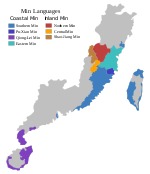Wenchang dialect
| Wenchang dialect | |
|---|---|
| 文昌话 | |
| Native to | Southern China |
| Region | Wenchang, Hainan |
| Language codes | |
| ISO 639-3 | – |
| Glottolog | None |
| Linguasphere | > 79-AAA-kdb 79-AAA-kd > 79-AAA-kdb |
Wenchang dialect (simplified Chinese: 文昌话; traditional Chinese: 文昌話; pinyin: Wénchāng huà) is a dialect of Hainanese which is spoken in Wenchang, a county-level city in the northeast of Hainan, an island province in southern China. It is considered the prestige form of Hainanese, and is used by the provincial broadcasting media.
Phonology
The initials of the Wenchang dialect are:[1]
| Bilabial | Dental | Palatal | Velar | Glottal | ||
|---|---|---|---|---|---|---|
| Stop / Affricate | voiceless | t | tɕ | k | ʔ | |
| voiced implosive | ɓ | ɗ | ||||
| voiced | b | d | dʑ | g | ||
| Nasal | m | n | ŋ | |||
| Fricative | voiceless | ɸ | ɕ | h | ||
| voiced | (w) | (j) | ɦ | |||
| Lateral | l | |||||
The semivowels [w] and [j] are in complementary distribution with [ɦ], and may be treated as allophones of the same phoneme.[2] The voiced stops /d/ and /g/ occur with only about ten words each.[3]
There are five vowels, /i/, /u/, /e/, /o/ and /a/.[4] The high vowels /i/ and /u/ may also occur as medials.[5]
The possible finals are:[6]
| Vocalic codas | Nasal codas | Stop codas | ||||||
|---|---|---|---|---|---|---|---|---|
| a | ai | au | am | an | aŋ | ap | at | ak |
| ia | iau | iam | ian | iaŋ | iap | iat | iak | |
| ua | uai | uan | uaŋ | uat | uak | |||
| e | ei | eŋ | ek | |||||
| ue | ||||||||
| o | oi | ou | om | oŋ | op | ok | ||
| io | iom | ioŋ | iop | iok | ||||
| i | iu | |||||||
| u | ui | un | ut | |||||
There are also two syllabic nasals, /m̩/ and /ŋ̍/, which occur in a total of three words.[7]
Wenchang dialect has six tones on isolated syllabes:[8]
| Middle Chinese tone | ||||
|---|---|---|---|---|
| level (píng 平) | rising (shàng 上) | departing (qù 去) | entering (rù 入) | |
| upper (yīn 阴) | 44 | 21ʔ | 11 | 51ʔ |
| lower (yáng 阳) | 33 | 42ʔ | ||
References
- ^ Woon (1979a), pp. 66–70.
- ^ Woon (1979a), p. 70.
- ^ Woon (1979a), pp. 69, 70.
- ^ Woon (1979a), p. 73.
- ^ Woon (1979a), pp. 74–75.
- ^ Woon (1979a), pp. 71–75.
- ^ Woon (1979a), pp. 72, 75.
- ^ Woon (1979a), pp. 75–81.

